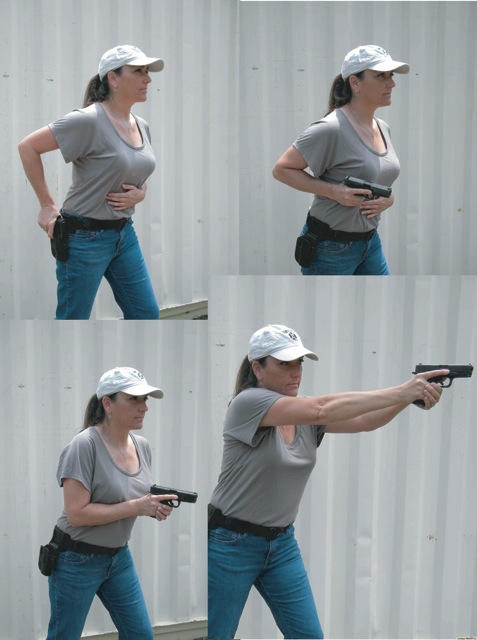 |
Rich’s column in Tuesday’s Wire is spot on. The ability to draw, or present the pistol properly – which means safely and efficiently – is incredibly important. Unfortunately it’s something that the majority of shooters never really practice. “But,” they say, “I shoot regularly.” And most can shoot accurately. But, force them to draw the weapon at full speed from concealment – for example during Force On Force training – which may be to the low-ready or on target to engage, and things get ugly.
Once I received proper instruction on how to draw the pistol – during a Gunsite Handgun class – I dedicated myself to actually learning to draw. I put in thousands of hours on the presentation. Like any skill it takes repetition, and dry practice is the way. But, initially part of my problem was not doing it from concealment. Your practice should be as you carry, same weapons, holsters and clothing or concealment.
As Rich mentioned a great number of your repetitions should be drawing to a low-ready position, as opposed to coming on target every time. Ask anyone who has drawn the pistol on a regular basis and they’ll tell you that actually presenting on target is a rare occurrence. And you never point it at someone until you’ve decided it’s time to shoot. Safety Rule II: Never point the muzzle at anything you’re not ready or willing to shoot. Numerous negligent shootings have occurred from people using the “Muzzle Intimidation” technique; pointing the muzzle at someone just to prove you’re willing to shoot them is never a good idea.
For defensive applications it’s also important to move while drawing the pistol. Moving - even if it’s only one step to the left or right – forces the threat back to the beginning of their OODA Loop. After forcing them into a reactive mode you continue to move, creating distance, getting behind cover or to get a clear angle of fire on the threat.
This initial, immediate movement is not natural. In fact, instincts tell you to root to the ground, whether you’re trying to orient to the exact nature of the threat, attempting to gather more details until finally deciding what to do, or you’ve decided to fight. While practicing your presentation – using carry gear and dressed accordingly – add movement into the sequence. It’s not natural, so it’s going to take a lot of repetitions for it to become automatic.
I do lots of dry practice on the draw and move. When I do get to the range, it’s lots of draw/move and fire one shot. The focus is marksmanship, extending the distances and making one accurate hit. After follow through, preparing to shoot again if necessary, everything slows down for a good scan. After scanning, looking for all the things that are important – other threats, family/friends, cover, an exit or law enforcement – I methodically, slowly work it back into the holster, ready to reverse it out and presenting the pistol again if it were necessary. Regardless of the live-fire repetitions, they are heavily outnumbered by the number of times I draw to the low-ready position.
As a community, and here at the Wire, the draw or presentation is a common subject. Your task is to take it beyond the academic and put these skills into practice - literally.
Tiger McKee is director of Shootrite Firearms Academy, located in northern Alabama. He is the author of The Book of Two Guns, AR-15 Skills and Drills, featured on GunTalk’s DVD, “Fighting With The 1911 and has regular columns in Gun Digest and American Handgunner.
http://www.facebook.com/pages/Shootrite-Firearms-Academy/156608611038230?ref=ts